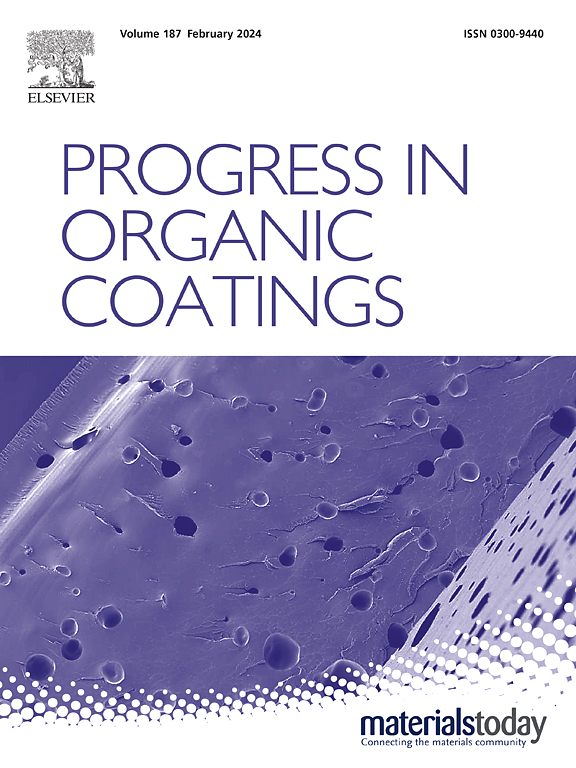Enhanced adhesion to low-surface-energy substrates using polyurethane acrylate/polyacrylate interpenetrating network pressure-sensitive adhesives
IF 6.5
2区 材料科学
Q1 CHEMISTRY, APPLIED
引用次数: 0
Abstract
In modern industrial applications, achieving strong adhesion to low surface energy materials, such as polyethylene, polypropylene, and polytetrafluoroethylene, is a significant challenge. This is primarily due to their inherent chemical inertness and weak interfacial interactions. To address this challenge, this study developed a novel pressure-sensitive adhesive with an interpenetrating network (IPN) structure. This was achieved by synthesizing linear polyethylene glycol-based polyurethane acrylate (PUA) oligomers and combining them with polyacrylate pressure-sensitive adhesives (PSA) to form the IPN structure. By adjusting the content of PUA, the viscoelasticity, mechanical, thermal, and adhesive properties of the PSA-PUA system were successfully optimized. The results demonstrate that the PSA-PUA20 exhibits excellent adhesion performance on polyethylene(PE) substrates, with a peel strength of 364.75 N/m and a loop tack of 4.03 N. Compared to polyacrylate pressure-sensitive adhesives (PSA), these values represent increases of 240.25 % and 46.58 %, respectively. Additional lap shear tests further confirmed that the PSA-PUA20 enables cyclic adhesion on polytetrafluoroethylene (PTFE) substrates. A mechanistic analysis reveals that the incorporation of PUA alters the surface energy of the adhesive, improving its spreading properties on low surface energy materials. Additionally, it strengthens the hydrogen bonds and van der Waals forces between molecular chains, significantly improving the cyclic shear performance and adhesion performance on low surface energy substrates. Furthermore, the PSA-PUA adhesive exhibits excellent antioxidant and thermal stability, offering a promising solution for the design of high-performance PSAs.
使用聚氨酯丙烯酸酯/聚丙烯酸酯互穿网压敏粘合剂增强对低表面能基材的附着力
在现代工业应用中,实现对低表面能材料(如聚乙烯、聚丙烯和聚四氟乙烯)的强附着力是一项重大挑战。这主要是由于它们固有的化学惰性和弱的界面相互作用。为了解决这一挑战,本研究开发了一种具有互穿网络(IPN)结构的新型压敏粘合剂。这是通过合成线性聚乙二醇基聚氨酯丙烯酸酯(PUA)低聚物并将其与聚丙烯酸酯压敏粘合剂(PSA)结合形成IPN结构来实现的。通过调整PUA的含量,成功地优化了PSA-PUA体系的粘弹性、力学性能、热性能和粘接性能。结果表明,PSA- pua20在聚乙烯(PE)基板上表现出优异的粘附性能,剥离强度为364.75 N/m,环粘性为4.03 N.,与聚丙烯酸酯压敏胶(PSA)相比,分别提高了240.25%和46.58%。额外的搭接剪切试验进一步证实,PSA-PUA20能够在聚四氟乙烯(PTFE)基材上循环粘附。机理分析表明,聚丙烯酸的加入改变了胶粘剂的表面能,改善了其在低表面能材料上的涂覆性能。此外,它还增强了分子链之间的氢键和范德华力,显著提高了低表面能基底的循环剪切性能和粘附性能。此外,PSA-PUA胶粘剂具有优异的抗氧化性和热稳定性,为高性能psa的设计提供了一个有前途的解决方案。
本文章由计算机程序翻译,如有差异,请以英文原文为准。
求助全文
约1分钟内获得全文
求助全文
来源期刊

Progress in Organic Coatings
工程技术-材料科学:膜
CiteScore
11.40
自引率
15.20%
发文量
577
审稿时长
48 days
期刊介绍:
The aim of this international journal is to analyse and publicise the progress and current state of knowledge in the field of organic coatings and related materials. The Editors and the Editorial Board members will solicit both review and research papers from academic and industrial scientists who are actively engaged in research and development or, in the case of review papers, have extensive experience in the subject to be reviewed. Unsolicited manuscripts will be accepted if they meet the journal''s requirements. The journal publishes papers dealing with such subjects as:
• Chemical, physical and technological properties of organic coatings and related materials
• Problems and methods of preparation, manufacture and application of these materials
• Performance, testing and analysis.
 求助内容:
求助内容: 应助结果提醒方式:
应助结果提醒方式:


